Business
UK inflation: What is the rate and why are prices still rising?
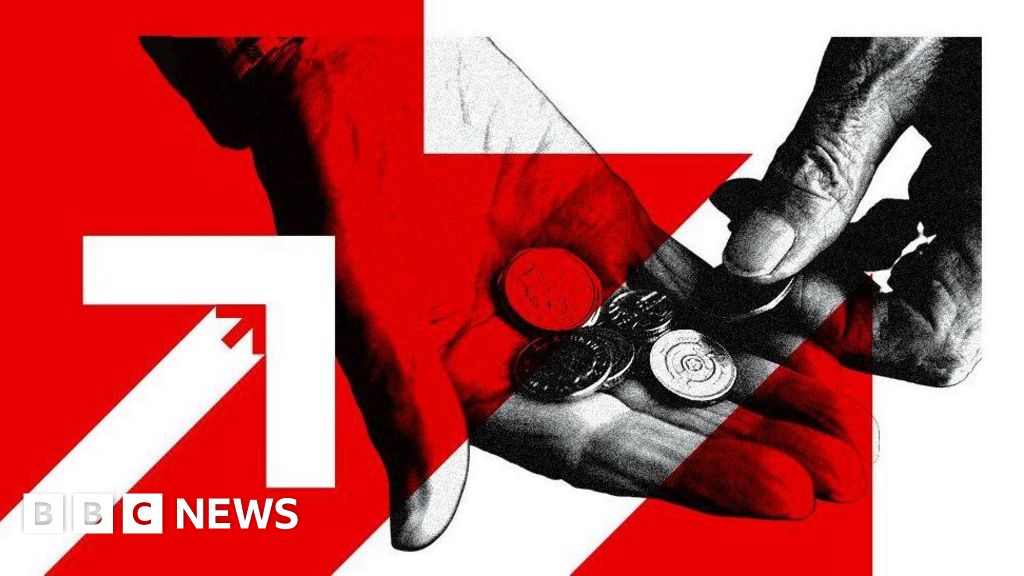
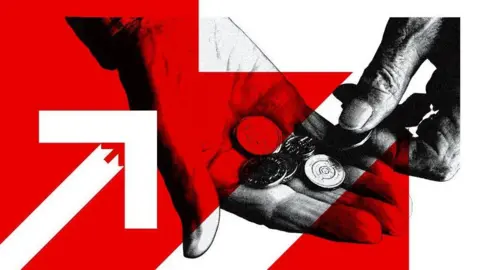 BBC
BBCPrices in the UK rose by 3.8% in the 12 months to July, driven by higher air fares, as well as increases in the cost of food.
It means inflation remains above the Bank of England’s 2% target.
The Bank moves interest rates up and down to try to keep inflation at that level, and has cut interest rates five times since August 2024.
What is inflation?
Inflation is the increase in the price of something over time.
For example, if a bottle of milk costs £1 but is £1.05 a year later, then annual milk inflation is 5%.
How is the UK’s inflation rate measured?
The prices of hundreds of everyday items, including food and fuel, are tracked by the Office for National Statistics (ONS).
This virtual “basket of goods” is regularly updated to reflect shopping trends, with virtual reality headsets and yoga mats added in 2025, and local newspaper adverts removed.
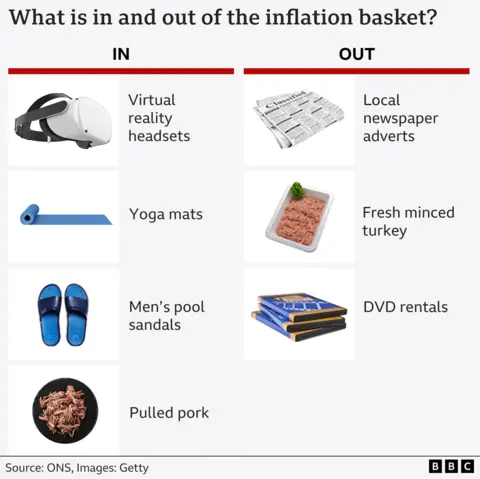
The ONS monitors price changes over the previous 12 months to calculate inflation.
The main inflation measure is called the Consumer Prices Index (CPI), and the latest figure is published every month.
CPI was 3.8% in the year to July 2025, up from 3.6% in the 12 months to June. The July 2025 figure is the highest recorded since January 2024, when the rate was 4.0%.
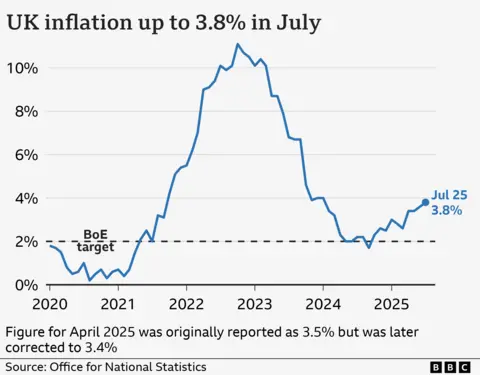
The Bank also considers other measures such as “core inflation” when deciding whether and how to change rates.
This doesn’t include food or energy prices because they tend to be very volatile, so can be a better indication of longer term trends.
Core CPI was 3.8% in the 12 months to July, up slightly from 3.7% recorded in the year to June.
Why are prices still rising?
Inflation has fallen significantly since hitting 11.1% in October 2022, which was the highest rate for 40 years.
But that doesn’t mean prices are falling – just that they are rising less quickly.
Inflation soared in 2022 because oil and gas were in greater demand after the Covid pandemic, and energy prices surged again when Russia invaded Ukraine.
It then remained well above the 2% target partly because of higher food prices.
These continue to be a significant factor in the current inflation figures.
Inflation for food and non-alcoholic beverages was 4.9% in the year to July, up from 4.5% in the year to June.
Beef, sugar, chocolate, instant coffee and fruit juice saw significant price rises.
But the main factor driving the July inflation figure was higher air fares, which saw the largest July increase since the ONS began collecting that data on a monthly basis in 2001.
In addition, fuel prices fell only slightly between May and June 2025, compared to a larger drop in the same period in 2024.
Why does putting up interest rates help to lower inflation?
When inflation was well above its 2% target, the Bank of England increased interest rates to 5.25%, a 16-year high.
The idea is that if you make borrowing more expensive, people have less money to spend. People may also be encouraged to save more.
In turn, this reduces demand for goods and slows price rises.
But it is a balancing act – increasing borrowing costs risks harming the economy.
For example, homeowners face higher mortgage repayments, which can outweigh better savings deals.
Businesses also borrow less, making them less likely to create jobs. Some may cut staff and reduce investment.
In recent months inflation has remained above the Bank’s target at the same time as the economy has remained relatively flat and the jobs market has softened.
Therefore, the Bank has chosen to cut rates, despite high inflation, in an attempt to encourage people to spend more and get businesses to invest and create jobs to boost the economy.
What is happening to UK interest rates and when will they go down again?
The Bank of England began cutting rates in August 2024, and made five cuts to bring the rate down to 4%.
Bank of England governor Andrew Bailey had said that future cuts will be made gradually and carefully.
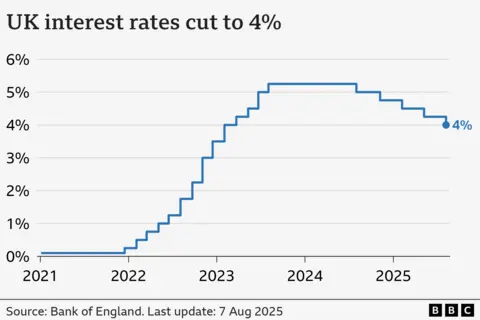
The August interest rate decision was extremely close, with the committee voting 5-4 to cut rates by a quarter percentage point.
It followed an unprecedented second vote by the Bank’s policymakers, as one economist wanted a larger cut of half a percentage point.
This suggests future interest rate decisions could also be finely balanced.
Inflation is now expected to peak at 4% in September, the Bank said in its latest Monetary Policy Report. That is twice the Bank’s target rate and above the 3.8% high it predicted in its previous report in May.
A further interest rate cut had been expected at the Bank’s meeting in November, but analysts are now less sure this will happen given the closeness of the August vote.
The Bank also has to consider the wider global economy. Mr Bailey has repeatedly warned about the unpredictable impact of US tariffs, and conflict in Israel and Iran has also created uncertainty.
Are wages keeping up with inflation?
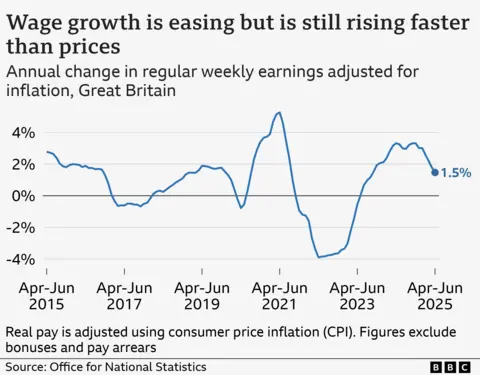
Annual average regular earnings growth was 5.7% for the public sector and 4.8% for the private sector.
Meanwhile, separate ONS figures showed the number of vacancies fell again to 718,000 for the May to July period, marking three continuous years of falling job openings.
The unemployment rate was 4.7% in the three months to July – the same as the three months to April.
This marked the highest level of unemployment since June 2021, and is also likely to factor into the Bank of England’s decision whether to cut rates again.
What is happening to inflation and interest rates in Europe and the US?
The US and EU countries have also been trying to limit price increases.
The inflation rate for countries using the euro was 2.1% in August, according to an early estimate.
In June 2024, the European Central Bank (ECB) cut its main interest rate from an all-time high of 4% to 3.75%, the first fall in five years.
By July 2025, after several further cuts, its key rate stood at 2%.
Inflation in the US held steady at 2.7% in July, remaining above the US central bank’s 2% target.
After a string of cuts in the latter part of 2024, the US central bank again chose not to change rates at its July 2025 meeting, the fifth hold in a row.
That leaves its key interest rate unchanged in a range of 4.25% to 4.5%.
The Federal Reserve has repeatedly come under attack from President Trump, who wants to see further interest rate cuts.
Business
Volkswagen capex recalibration: Automaker pares 2030 investment to $186 bn; China, US headwinds grow – The Times of India

Volkswagen Group plans to invest €160 billion ($186 billion) through 2030, a scaled-down outlay that reflects tightening capital allocation as Europe’s largest automaker grapples with mounting pressure in its two biggest markets — China and the United States, Reuters reported.The investment figure, announced by Volkswagen CEO Oliver Blume, is part of the company’s rolling five-year capital expenditure plan, which is updated annually. The latest commitment compares with €165 billion earmarked for 2025–2029 and €180 billion for 2024–2028, with 2024 marking the peak year for spending.Since that peak, the group — which houses brands such as Porsche and Audi — has been squeezed by higher costs and weaker margins, hit by US tariffs on imported vehicles and intensifying competition in China. The strain has been felt most acutely at Porsche, which derives nearly half of its sales from the US and China combined.Porsche recently unveiled a significant rollback of its electric vehicle strategy as profits came under pressure. Speaking to Frankfurter Allgemeine Sonntagszeitung, Blume said the focus of the latest investment plan was firmly “on Germany and Europe,” particularly in products, technology and infrastructure.Blume added that discussions on an extended savings programme at Porsche are expected to continue into 2026. He also said he does not expect Porsche to grow in China, though localising production across the wider Volkswagen group remains an option. A China-specific Porsche model could make sense at some point, he said.On Audi, Blume noted that any decision on building a manufacturing plant in the United States would depend on whether Washington offers substantial financial support.Blume, who will step down as Porsche CEO in January to concentrate fully on running Volkswagen Group, said his recent contract extension as Volkswagen chief executive until 2030 signalled continued backing from the Porsche and Piëch families as well as the German state of Lower Saxony, the company’s largest shareholders.“But it is true, of course, that shareholders have suffered losses since Porsche went public three years ago. I, too, must face up to this criticism,” he said.
Business
Power as ‘currency’: Experts say data centre growth lifts demand; India poised for global leadership – The Times of India

India’s expanding data centre and artificial intelligence ecosystem could position the country as a global leader in power trade, with experts pointing to surplus electricity capacity and rapid reforms in the power distribution sector, according to speakers at a national conference on energy and technology.Speaking at the National Conference on AI and Machine Learning based solutions in the power sector, Jitendra Srivastava, chairman and managing director of REC Limited, said the rapid rise of AI and data centres is creating a new era where electricity itself becomes a strategic asset, according to ANI.“With the exploding growth of artificial intelligence, with the exploding growth of data centres, with the sheer amount of power required to function these places…We are going to see an era when power will be the currency and we are uniquely placed with its huge potential with its already surplus status. We are poised to become world leaders. We are in a position where we can show the world that power is a tradable commodity and we can be global leaders in this,” Srivastava said.The conference brought together solution providers and power distribution companies with the aim of enabling collaboration and innovation. Shashank Mishra, Joint Secretary in the Ministry of Power, said the initiative was designed to create a common platform for developing new solutions.“Today we are bringing together solution providers and distribution companies on a single platform where they can interact and develop new solutions and ideas. We are also presenting several innovative concepts in the form of solutions, and the best among them will be awarded by the Minister of Power,” Mishra told ANI.He added that the government expects the initiative to be “a transformative” step for the sector.Highlighting ongoing reforms, Srivastava said the Ministry of Power has been driving changes under the Revamped Distribution Sector Scheme (RDSS), with smart metering forming a core pillar of the programme. He stressed that the benefits of smart meters can be fully realised only with the use of advanced analytics.“To understand the advantages of smart metering, it is essential to leverage the power of artificial intelligence and machine learning,” he said, adding that such tools can aid anti-theft measures, load forecasting and system rationalisation.According to Srivastava, the conference seeks to demonstrate how AI- and machine learning-based tools can improve consumer services, assist electricity regulators and help discoms function more efficiently.India’s energy sector has strengthened significantly in recent years, balancing rising demand with sustainability goals. Citing International Energy Agency projections, speakers noted that emerging and developing economies will account for about 85 per cent of the growth in global electricity demand over the next three years, with India playing a central role.As of June 2025, India’s total installed power capacity stood at 476 GW, while power shortages have declined sharply from 4.2 per cent in 2013-14 to 0.1 per cent in 2024-25, according to official data.
Business
‘Next big clean-up’: FM Sitharaman flags customs simplification; hints at duty rationalisation in Budget – The Times of India

Ahead of Budget 2026, Finance Minister Nirmala Sitharaman on Saturday said simplifying India’s customs framework will be the government’s next major reform focus, signalling a comprehensive clean-up aimed at making compliance easier and more transparent.Speaking at the HT Leadership Summit, Sitharaman said customs reforms would follow the rationalisation efforts already undertaken in income tax and Goods and Services Tax (GST) to boost consumption by leaving more cash in the hands of consumers, PTI reported.“We need a complete overhaul of customs… we need to have customs simplified for people to feel that it is not cumbersome to comply… need to make it more transparent,” the finance minister said.She said the government intends to bring the same virtues of transparency and ease that guided income-tax reforms to the customs regime, adding that the proposed changes would include further rationalisation of customs duty rates.The finance minister indicated that announcements to this effect may be made in the Union Budget, likely to be presented on February 1.“We have brought down customs duty over the last two years steadily. But in those few items where our rates are considered to be over the optimal level, we have to bring them down as well. Customs is my next big cleaning-up assignment,” she said.In this year’s Budget, the government proposed eliminating seven additional customs tariff rates on industrial goods, following the removal of seven tariff slabs in 2023-24. This reduced the total number of customs tariff slabs to eight, including a zero rate.On the rupee’s sharp depreciation, Sitharaman said the currency would find its natural level. The rupee has weakened about 5 per cent against the US dollar during calendar year 2025.The currency breached the 90-per-dollar mark for the first time earlier this week, settling at a provisional all-time low of 90.21 amid sustained foreign fund outflows and elevated crude oil prices, PTI noted.On economic growth, Sitharaman expressed confidence that India’s GDP expansion would remain at 7 per cent or above in the current financial year.The Indian economy grew at a six-quarter high of 8.2 per cent in the July-September quarter, aided by stronger factory output and robust services-sector performance, offsetting a slowdown in farm output. Growth stood at 7.8 per cent in the preceding quarter and 5.6 per cent a year earlier.For the first half of the financial year ended September, India clocked GDP growth of 8 per cent.
-

 Tech6 days ago
Tech6 days agoGet Your Steps In From Your Home Office With This Walking Pad—On Sale This Week
-

 Sports5 days ago
Sports5 days agoIndia Triumphs Over South Africa in First ODI Thanks to Kohli’s Heroics – SUCH TV
-

 Entertainment5 days ago
Entertainment5 days agoSadie Sink talks about the future of Max in ‘Stranger Things’
-

 Fashion5 days ago
Fashion5 days agoResults are in: US Black Friday store visits down, e-visits up, apparel shines
-

 Politics5 days ago
Politics5 days agoElon Musk reveals partner’s half-Indian roots, son’s middle name ‘Sekhar’
-

 Tech5 days ago
Tech5 days agoPrague’s City Center Sparkles, Buzzes, and Burns at the Signal Festival
-

 Sports5 days ago
Sports5 days agoBroncos secure thrilling OT victory over Commanders behind clutch performances
-

 Sports5 days ago
Sports5 days agoF1 set for final-race showdown as Verstappen exploits McLaren blunder | The Express Tribune






